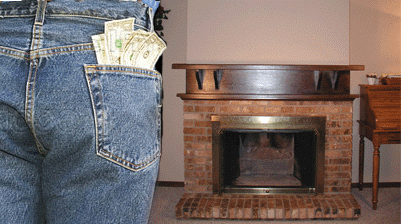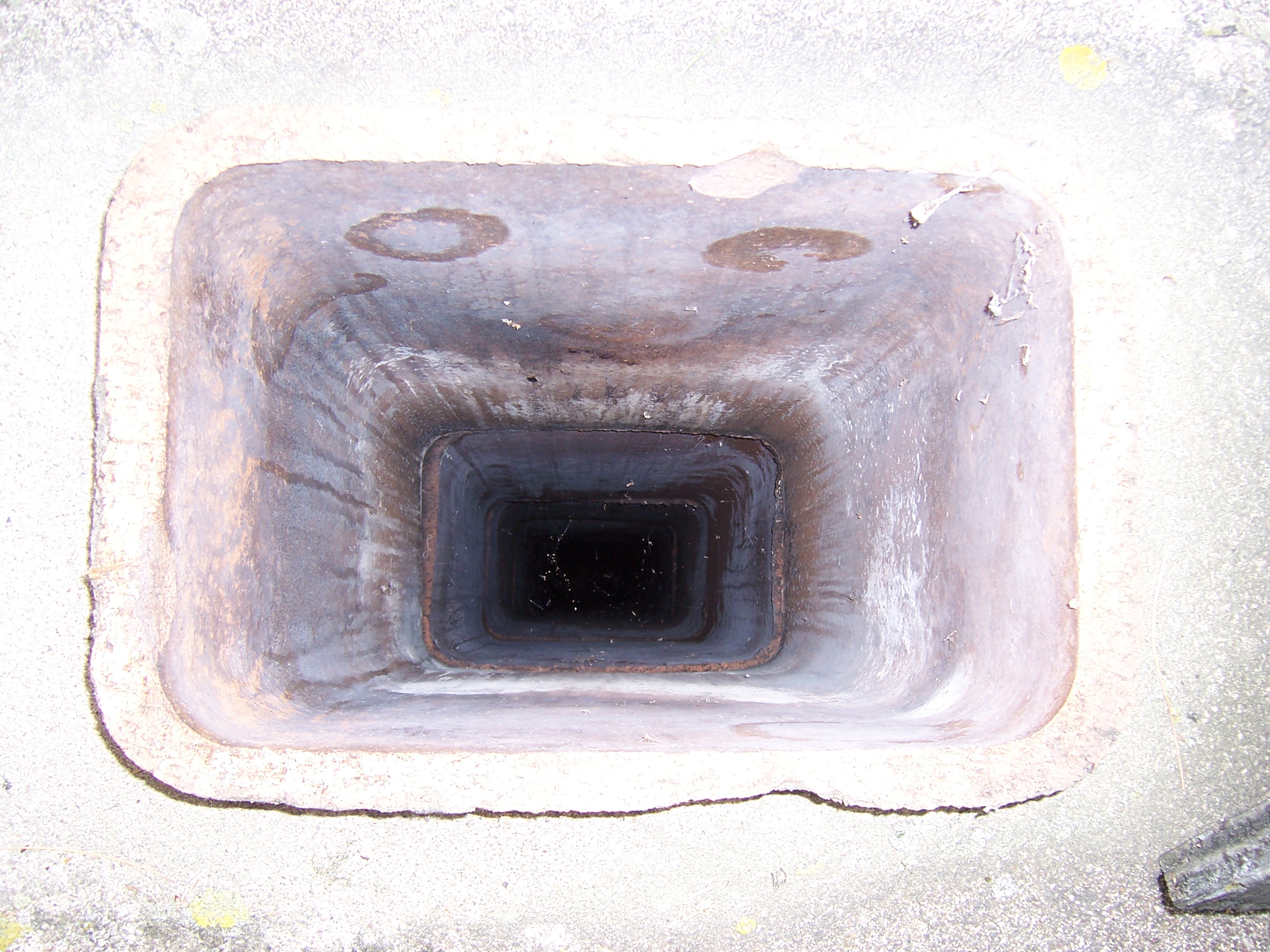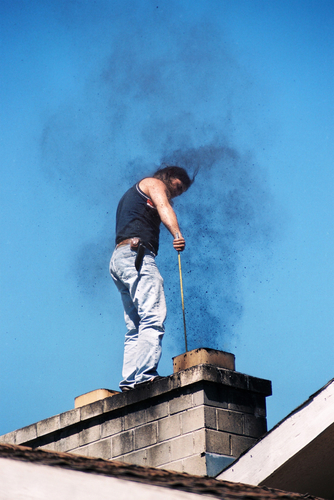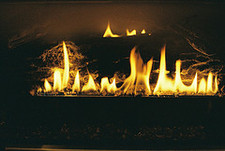by blogediter | Feb 8, 2019 | Chimney Plugs
Q: I accidentally ignited my gas fireplace under my Chimney Balloon (someone had removed the red reminder card from the gas spigot). It fell out of the chimney within 10 seconds. Can I patch the burn hole in my Chimney Balloon? At what temperature does the Chimney Balloon melt and burst? – JG
A: JG, Well your Chimney Balloon did exactly what it is supposed to do when a fire is lit under it, but unfortunately it is not repairable when melted. The hole is going to be just too big.
The answer to your second question is 180 – 220 degrees Fahrenheit it the average melting point of the Chimney Balloon if it is exposed to flame. Your gas fireplace came up to that temperature very rapidly, as gas fireplaces tend to do. Wood fireplaces tend to get to temperature a little slower, but it doesn’t take long for the Chimney Balloon to sacrifice its life for yours. – Jason

by blogediter | Dec 31, 2018 | Gas Logs
Fireplace Sucks amin
What would you do if the directions of your vented gas log fireplace said: “Step 4: Turn on the gas and light log set with a flaming $10 bill”. No matter what you tried, you couldn’t get the gas log to light unless you burned a $10 bill and put it to the logs to light it. I think you would be tempted to write the manufacturer about this issue, or talk to the store you bought it from, or maybe just not use it!
The inefficiency of a vented gas log fireplace
In a way, this is what it is like to use a vented gas log fireplace. You get little to no usable heat from the device, you consume fuel in it, its use/or non-use sucks heat from your home, but it sure makes a nice flickery flame. Is it worth it?
There are some key elements that are dead wrong with vented gas log kits. The primary issue is the damper use with these kits. Most state building codes say if a vented gas log is installed in a fireplace the metal damper has to be locked open or removed. The reason for this particular code is so that people don’t turn on their vented gas log and forget to open the damper and therefore asphyxiate the inhabitants of the home. The reality of this code is the homeowner has to live with a sizable hole in their homes energy envelope that is releasing energy 24/7.
Vented gas logs do not produce usable heat
The vented gas logs combustion process does little to produce usable heat to the living area. Much like a wood burning fireplace, the vented gas log wastes heat in many ways. The combustion process grabs already heated air from your home and burns the oxygen and combustible gasses in it. The heat that is created in this combustion quickly rises and grabs more heated inside air and tosses it up the chimney. You can restrict the amount of inside air that the fireplace has access to by installing glass doors, but this will also severely limit the amount of radiant heat that fireplace can cast forward into your living space. This radiant heat is the heat you feel on your skin in front of the fireplace and is the only usable heat that the fireplace will produce since the combustion heat is pouring out the top of the chimney. In the meantime, the home is drawing in cold outside air from other places (i.e. windows, light sockets, doors, etc) to replace the air that is escaping the home through the chimney. This is referred to as the “stack effect”.
How much money and heat is lost?
Most vented gas log operate at a consumption of .5 to 1 Therm per hour. In January of 2008 one Therm of Natural Gas cost me $1.57. So if you burn your vented gas log for 3 hours you wasted $4.71 worth of fossil fuels, and have no heat to show for it. With that same amount of natural gas you could have heated a 1200 sq ft home with a 95% efficient power vent furnace all day long.
Vented gas logs are good for ambiance
The flickery yellow flame that is produced by a vented gas log is a very realistic looking flame, but it is a low temperature flame and therefore tends to burn “dirty” and outputs soot and other pollutants. If you have a vented gas log fireplace or are considering having your wood fireplace fitted for one. Consider first the cost and environmental ramifications of using it.

by blogediter | Oct 1, 2018 | Chimney Problems
Chimney noise stoppers
This was a post about Chimney balloons as a noise stopper or noise barrier found on Google groups at this link: I thought it was interesting. http://groups.google.com/group/alt.home.repair/browse_thread/thread/5d0efc3c31e9eac4?hl=en
Q: I’m having troubles with my fireplace insert. I’m having a quite tall chimney and for some reason, there’s no top or bottom damper in the chimney. When’s a windy weather, it makes very unpleasant noise in the fireplace insert, I hear the wind very loud. How can this be solved, please? – Matt
A: I was having trouble with street noise and pigeon cooing noise coming from my fireplace chimney. It was quite annoying, especially at night. I put in a Chimney Balloon to buffer the noise and it has helped quite a bit. It seems to have stopped some of the cold air passage as well. I also put out some of those pigeon spikes near the top of the chimney but that didn’t deter the little flying rats.

by blogediter | Sep 24, 2018 | Chimney Plugs
Clean Your Own
This is a summary of a phone conversation I had with a very nice older woman in a North suburb of Chicago. I will refer to her as Mrs. G:
Mrs. G: Thank you for the information on the Chimney Balloon. I hired a chimney sweep to come to my home so I could have him measure to fit a Chimney Balloon.
Jason: That is a great idea. I know you expressed concern about getting your old damper open as it has rusted closed. How did that work out for you?
Mrs. G: It went well but the chimney sweep suggested an Exhausto Chimney Fan so I can seal up my chimney. He said it would cost about $900 to install one.
Jason: Exhaust makes a very good product Mrs. G. but I thought you said you do not use this fireplace at all?
Mrs. G: I never use this fireplace but the sweep told me this was a good way to stop heat loss through the chimney.
Jason: Well the Exhausto does have a feature that tops the chimney when it is not blowing, but if you really want to top your chimney it would be best to just have the sweep cap the chimney with a top cap plug.
Mrs. G: The sweep told me that the Exhausto will keep me from losing heat out the chimney and act as a top sealing damper.
Jason: Yes, but primarily the Exhaust is made to draw air up the chimney. It is perfect if you had a chimney that did not draft well and you use it often. In my opinion, You would be better served to get a more economical top sealing damper, like the ones made by Lymance, if you are looking to seal the fireplace at the top and you would like to still have the option of using it. If you don’t plan to use the fireplace and you never have, and if you have no known smoke draft problem, you would be wasting money by installing an exhausted. Is this Chimney Sweep someone that you know and trust.
Mrs. G: Well, this chimney sweep is from the yellow pages, I have not used him before. But he says he knows what he is talking about. He thinks this will work to create the right amount of air in my chimney so it won’t be cold anymore.
Jason: Mrs. G. I think this guy is trying to up-sell you and does not have your best interest in mind. I would call another sweep and have him look at your fireplace. Ask him if he thinks a Chimney Balloon or a top sealing damper would work best for you.
Mrs. G: Well I already have signed the estimate for the Exhausto so they are installing it tomorrow since they had a cancellation.
Jason: Mrs. G I would encourage you to call to see if you can have this guy let you out of that estimate. I really encourage you to have another person look at this first. We can look up some reputable chimney sweeps through the National Chimney Sweeps Association and get you another opinion.
Mrs. G: Maybe that would be good I will call him and call you right back
Jason: OK, in the meantime I will look up some reputable sweeps in your area. I will have you a few phone #s by the time you call back.
Mrs. G: OK Jason, thanks, goodbye.
Mrs. G never called me (Jason) back. I can only assume this chimney sweep talked her into the installation again. I didn’t care if she bought a chimney balloon or not. I actually thought a lock top damper may be what she wants. But I knew for sure an exhaust was going to be overkill.

by blogediter | Sep 21, 2018 | Gas Logs
Gas Burn
Q: Jason, I have a wood fireplace right now but no supply of wood. I am thinking of converting to a gas log fireplace to supplement my home heat. What do you think? -CM
A: CM, I have my opinions on this but this story from a customer speaks so well on the subject I will share that with you instead:
“…If you live in a cold climate area I wouldn’t really recommend you do anything with a wood burning fireplace, but plug up the chimney and maybe put a few candles in it. Why?… because I learned the hard way that fireplaces and gas logs are excellent ways to suck money right out of your pocket.
A few years ago I thought I would supplement my heat by burning wood in my fireplace. Turns out my heating bill went up because the fireplace was sucking the air out of my house when I burned. So I converted to a gas log fireplace (which it sounds to me like you have a partial gas log setup right now that needs fixing.) Well, part of having a gas log installed to code is to disable the damper or clip it open. This was even worse! I was constantly losing heat and the living room was drafty.
I ended up plugging the chimney with a Chimney Balloon to stop the cold draft from coming down the fireplace flue. This was allowable under code since the Chimney Balloon would melt and fall out if I accidentally light a fire under it. You see, this stupid “disable the damper building code” is only there so people don’t light a gas log and leave the damper closed on accident and therefore asphyxiate everyone in the house or set the place ablaze.
OK, long story short…I ran up my heat bill and spent $500 on a professionally installed gas log only to end up with a fireplace I don’t use because it wasted too much heat. So I put candles in it and plugged it with a Chimney Balloon.” – Terry B



